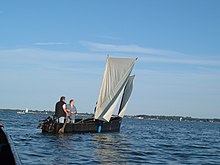Spritsail

As Sprietsegel quadrangular are sail of a ship or boat designated by a spar , diagonal, a round timber from the Mast splayed be.
description
Like all sails attached in the longitudinal direction of the ship, spritsail belong to the Schrat sails . The rod on which they are stretched is called Spriet , and its protruding end piece is called Piek . The four edges ( leeches ) of the sail are named upper , aft , lower and luff , the corners are called head , neck , clew and spriethorn or prick .
A special form of Sprietsegels is the Spreizgaffelsegel on Spreizgaffelketschen and Spreizgaffel savers . It is attached to a spreading gaff that is guided between two masts. Spreading sails are also widespread in the South Seas and are held there by means of curved gaffs .
history


The Sprietsegel is the oldest Schratsegel in sailing shipping. It can be seen since the 2nd century BC. On smaller Hellenistic vessels with a focus on the northern Aegean ; During the imperial period , its western area of distribution extended to at least Rome . The grave reliefs of ancient sailors show coastal vehicles, harbor boats and tugboats with a mast set up far forward in the bow , to which the rectangular canvas stretched by the diagonal spar is loosely attached.
Modern types of ships on which spritsail were used were, in addition to many fishing boats, the sea-going quases and the bojer .
Smaller work and transport ships on inland waterways also had a spray rig , in which the spray sail represents the main or mainsail . Some traditional boat types of this type are still in use today, such as the Steinhuder peat barge and the Blekinge boats that are common in southern Sweden . An example of the use of spritsail sails on larger inland vessels can be found in the fleet of the German Maritime Museum with the Emma barge with a three-masted spritsail rigging .
The spritsail is used today in different parts of the world. In western countries it is still used today on smaller dinghies and sport dinghies , especially the Optimist (Opti). The case with which the tension on the sail is also adjusted in the Optimist is called Sprietfall .
Individual evidence
- ↑ Schult, Joachim: Segler-Lexikon. Keywords: spray sails and spray rigging , p. 483
- ↑ Casson, Lionel (1995), pp. 243-245, 332, 337
- ^ Casson, Lionel (1954), pp. 217-219
- ↑ Blekinge Museum in Karlskrona , "Båtritningar" (for example: boat plans or drawings), accessed on: May 5, 2018 ( Memento of May 5, 2018 in the Internet Archive )
- ^ EMMA - German Maritime Museum. Retrieved November 2, 2018 .
literature
- Schult, Joachim: Segler-Lexikon. Bielefeld: Delius Klasing, (9th edition) 1994, ISBN 3-87412-103-8
- Casson, Lionel (1954): "The Sails of the Ancient Mariner", in: Archeology , Vol. 7, No. 4, pp. 214-219
- Casson, Lionel (1995): "Ships and Seamanship in the Ancient World," Johns Hopkins University Press, ISBN 978-0-8018-5130-8
